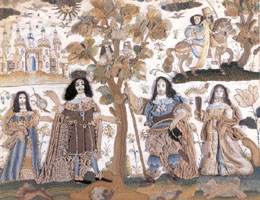Stumpwork Embroidery

It originally started with people padding small areas of crewel embroidery, and during the 17th Century (Jacobean period) became a technique in it's own right, with the raised work becoming more and more elaborate.
It was also during the 17th Century that some of the most spectacular stumpwork pieces emerged, as well as it reaching the height of popularity in this time.
In recent times, it has enjoyed resurgence in popularity, and once again the technique has evolved, so that instead of the figures being raised by padding, florist wire is also used to bring the embroidered figures completely off the fabric.
Stumpwork Designs
Many 17th Century stumpwork pieces depict fanciful pastoral scenes, with very well dressed shepherds and shepherdesses being central figures.
As time went on, embroiderers started to work panels depicting historical figures or special events.
The piece below is in the Holburne Museum and is one of a series depicting the return and coronation of Charles II following the Restoration of the English monarchy.

The piece is roughly the size of an A3 piece of paper and is filled with symbolism, as well as depicting in small “mini pictures” incidents from Charles II’s escape.
This is typical of stumpwork pieces, which do tend to include a lot of symbolism (the Tree of Life is a favourite – as it is in samplers) and a number of different scenes within the piece.
Spangles, human and animal hair and metal thread feature heavily within the designs.
Modern stumpwork designs tend to lean heavily towards flowers and insects, often using rayon threads to give sheen. Unlike many historical pieces, modern designs often have only one figure in them, with that being the entire focus of the piece.
Stumpwork Techniques
Historical stumpwork pieces became more and more elaborate as time went on, and eventually human figures were almost like small dolls, dressed in elaborate costumes (often using scraps of fabric from the making of the embroiderers own clothing), and using human hair for hair and beards.
The raised figures were padded with wool, felt and even small pieces of wood or over layers of parchment (in much the same way as goldwork). Sometimes figures were stitched over a wire frame, and then attached to the fabric.
All of these methods are still used today, however the favourite is the wire frame technique.
Stumpwork Stitches
Most stumpwork pieces utilise crewel embroidery stitches – in fact many of these (such as detached buttonhole and trellis couching) lend themselves ideally to stumpwork.
You will also find satin stitch, long and short stitch, back and stem stitches, as well as chain stitches.
Stumpwork is a very intricate looking piece of embroidery, but, with a little practice, it is fairly simple to pick up the techniques and produce a spectacular piece of work.
Recommended Reading
Beginner's Guide to Stumpwork
Stumpwork Dragonflies (Sally Milner Craft Series)
A-Z of Stumpwork (A-Z Needlework 09)
Try Stumpwork with these Free Patterns
Holly and Berries by Karen Buell Designs
Buttercup from Jean Fletcher’s Stumpwork
Links
Elizabethan Raised Embroidery by Branwen Madyn Wallis
Stumpwork from White Works website
Is there anything that you would particularly like to see an article on? If so, please contact me with your suggestions.
Happy Stitching

© 2009 Megan McConnell
This site needs an editor - click to learn more!
You Should Also Read:
Embroidery Forum
Related Articles
Editor's Picks Articles
Top Ten Articles
Previous Features
Site Map
Content copyright © 2023 by Megan McConnell. All rights reserved.
This content was written by Megan McConnell. If you wish to use this content in any manner, you need written permission. Contact
BellaOnline Administration
for details.


